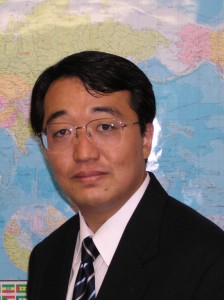緊張と統合:内村鑑三におけるキリスト教と日本の精神
このシリーズでは、私が1994年に執筆した統一神学大学院(Unification Theological Seminary)の神学課程修士論文(Divinity Thesis)を日英二か国語で掲載している。
3.無教会運動における司牧の概念の続き
内村の教会観は、彼の最初のキリスト教との出会いにその根源がある。1878年6月に、内村と他の五人の札幌農学校の生徒達は、農学校のキリスト教回心者を精神的に導くために訪れた、米国メソジスト監督教会のM・C・ハリス牧師から洗礼を受けた。その前年に、「イエスを信ずる者の契約」に署名していた新しく洗礼を受けた生徒達は、自分達が特別の友情で結ばれていると感じ、独自の集会を作ることを決めた。もう一人の生徒がグループに加わり、内村の言う「七人兄弟の小さな教会」が作られたのである。その「小さな教会」は制度上まったく民主的であり、七人の会員はみな権威と義務の点で平等であった。この経験は、内村の生涯を通して、真のキリスト教に対する理想と懐古的なイメージとしての役割を果たすことになるのである。この時に彼は初めて教派主義と直面している。
人数は我々の聖なる仲間に加えられつつある、神に感謝する。一つの事が我々には残念であった、すなわち我々がこの小さな場所に二つの教会をもつようになる明白な傾向があった、一つは聖公会、他はメソヂスト教会であった。『主一つ、信仰一つ、バプテスマ一つ』と、我々は心の中で考えはじめた。一つでさえ自分の足で立つだけ強くないのに、二つの別々の基督教団体をもつ必要が何処にあるか。我々は我々の基督信徒の経験においてはじめて教派主義の弊害を感じた。(岩波、「余は如何にして基督信徒となりし乎」、p.56-57)
内村とその友人達は、始めから一つの統一された札幌教会を心に描いていた。そこで、これまでに二人の異なる宣教師により、異なる教派への洗礼を受けていたメンバー達は、札幌に新しい独立した教会を建てるために、その教派への所属を放棄したのである。メソジスト派の宣教師は、内村のグループが新しい教会の建物を建築するのにお金を貸していたが、彼らが自分の教派に属そうとしていないことを知ると、直ちに借金を返済するように命じて来た。内村とその友人達は、独立し、統一された札幌教会においてキリストに仕えることを強く再確認し、一年以内に借金を返すことを誓ってこれに応じた。そして多大なる犠牲を払ってその誓いを果たしたのである。内村はこの事件を決して忘れることがなかった。それは彼が終生持ち続けた、外国の宣教師と教派主義に対する否定的な態度と、精神的・経済的独立を共に成し遂げようとする決意とを形成したのである。
III. Concept of Ministry in Mukyokai Movement (Cont.)
Uchimura’s view of the church has its root in his earliest encounter with Christianity. In June of 1878, Uchimura and five other students at the Sapporo Agricultural College were baptized by the Reverend M. C. Harris, an American Methodist Episcopal missionary who visited the college periodically to provide spiritual guidance for the Christian concerts there. The newly-baptized students, having signed a “Covenant of Believers” the previous year, felt themselves linked in a special fellowship and decided to form a congregation of their own. With the addition of another student, the “little church of seven brothers,” as Uchimura called it, was established. The “little church” was entirely democratic in structure, all seven members having equal authority and responsibility. This experience was to serve as an ideal and nostalgic image of the true Christianity throughout his lifetime. At this time he first confronted denominationalism.(4)
Numbers are being added to our holy company, thank God. One thing we were sorry about; i.e. there were distinct tendencies for our having two churches in the little place, one an Episcopalian, and the other a Methodist church. “One Lord, one faith, one baptism,” we began to ponder in our hearts. What is the use of having two separate Christian communities, when even one is not strong enough to stand upon its own feet. We felt for the first time in our Christian experience the evils of denominationalism.(5)
From the beginning, Uchimura and his friends envisioned a single, united church in Sapporo. Hence, the members who had been baptized earlier by two different missionaries into two different church denominations withdrew their denominational affiliation to establish a new independent church in Sapporo. When the Methodist missionary, who had loaned the money for the new church building, learned of the disaffiliation of Uchimura’s group from his denomination, he demanded immediate repayment of the money. Uchimura and his small band responded with a strong reaffirmation to serve Christ in an independent, united church in Sapporo and with a pledge to repay the debt within a year, a pledge they fulfilled with great sacrifice. Uchimura never forget this incident. It permanently shaped his negative attitude toward foreign missionaries and denominationalism and his determination to achieve both spiritual and financial independence.(6)
(4)Caldarola, p.42.
(5)Uchimura, “How I became a Christian,” in The Complete Works of Kanzo Uchimura, with notes and comments by Taijiro Yamamoto & Yoichi Muto, 7 vols, (Tokyo; Kyo Bun Kwan, 1971), vol.2, p.57
(6)Robert Lee, “Service to Christ and Country: Uchimura’s Search for Meaning” the Japan Christian Quarterly, vol. 54, No.2, (Spring 1988), p.94.
